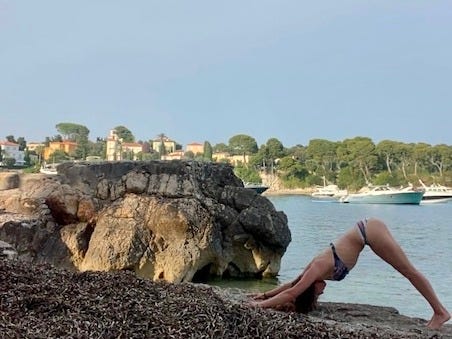We see and hear it everywhere: “movement is medicine.” It’s true, but it’s not to be overlooked that intentional stillness is medicinal, too.
The movement statement is of course nuanced if you’ve experienced an injury through physical activity—like when I tripped backstage before a dance performance and hobbled my way through a full hip-hop routine on what I later discovered was a broken foot, not-so-ironically called a Dancer’s Fracture (joke was on me). Then movement might not feel so healing in the moment.
It’s also true that life happens—things fall apart or unravel; big physical or emotional transitions can swallow our time, energy, and capacity. Sometimes movement doesn’t feel as good as it used to—sometimes it feels straight up impossible.
While stillness can also be healing, it’s of course not medicinal if you’re barely moving—or if you’re only using stillness to scroll, dissociate, and check out.
And it’s not like any of us are immune to hypnotizing external forces, but if we’re constantly flooding our stillness and headspace with noise, content, and distraction, then we’re just stationary and overstimulated.
It’s also unhealthy if we’re using movement as an excuse to avoid rest, restoration, or checking in with ourselves and others.
Like all things Wellness, it’s all so personal.
The benefits
Courtesy of the growing wellness hype, you probably already know that a balanced blend of physical movement and intentional stillness supports the body and mind.
For example, both practices can:
Regulate the nervous system and digestive health.
Improve blood pressure, sleep quality, energy, and immunity.
Reduce stress, anxiety, and symptoms of depression.
Enhance memory, mental clarity, focus, and awareness.
Support emotional resilience and release.
Sharpen the connection to body, breath, and present moment.
*Dr. John Douillard is a great resource for making this type of research digestible and actionable, and for linking modern science with ancient wisdom—namely Ayurveda.
Just like movement can help us physically process emotions—running, dancing, crying or sighing your way through sun salutations—stillness offers space to mentally sit with how we feel.
Emotions live in our bodies, so just as swimming, sprinting, or weightlifting can flush out sticky energy, sitting in stillness—with awareness—can offer the space to observe and process emotions without bypassing or running from them.
Doing a handstand or hiking / biking a steep trail might remind you how strong and capable you are.
Stillness might remind you that you’re already enough as you are—even when you’re doing nothing at all.
The balance
If you’re always on the move or feel like you can’t slow down for whatever reason, stillness—alongside a steady, slower breath—could be a wonderful antidote. It can reconnect you with softness, groundedness, and presence.
If you’re mostly sedentary or mentally stagnant, mindful movement might help remind you of the miraculous abilities of the body. It could give you physical energy and mentally light you up.
The name of the game is mindfulness and intention—because without these, we tend to robotically clunk along in ways that keep us out of balance and disconnected from ourselves, our choices, and each other.
When we aim to pay mindful attention, we can start to notice what we need more or less of physically, mentally, and emotionally—whether it’s activity and action, rest and space, or internal inquiry and emotional regulation tools.
If we check out and ignore ourselves, then we’re probably missing a lot of physical and mental cues, which can keep us stuck in unbalanced autopilot and mind-body disconnection. We might never achieve absolute perfect balance between it all (bye byeee perfectionism), but staying more consistently connected can certainly help a lot.
Not everyone wants to reconnect though, which is fine for them. But disconnection doesn’t contribute to a more connected and united future as a collective, and it doesn’t lead to a healthier ecosystem (no blaming or shaming—we’re not all surfing the same wave!).
When we’re more tuned in to who we are, how we feel, and what we need, the more effectively we’ll be able to care for ourselves, each other, and the planet—even when life gets messy.
For me, life feels the most meaningful when I land in that sweet spot of living intentionally without trying to control it all to a T—when I allow the ebb and flow between surrender and agency; between action and rest.
This creates a balanced sense of mind-body stability and fluidity that is essential for physical, mental, and ecological wellbeing.
Resources & reflections
Whether you seek movement or stillness, I have offerings that might be helpful:
A variety of free yoga and mindful movement videos on YouTube.
Donation-based meditations on Insight Timer.
Personalized yoga sessions or holistic health coaching—intro calls are free.
So, to reflect and to wrap it up:
What do you need more of today—stillness, or movement?
What’s your unique sweet spot of stillness and movement in this stage of your life?
How can you check in—whether you’re seated or in motion?
Let me know—feel free to share with someone who might need the reminder.
Maybe we can give Wellness an upgrade to make it feel more authentic, inclusive, and sustainable… thoughts?
Take good care,
S






